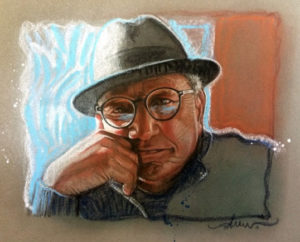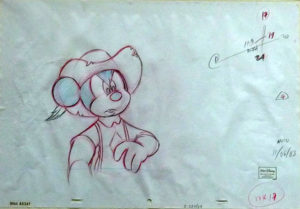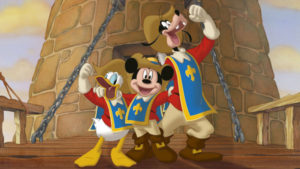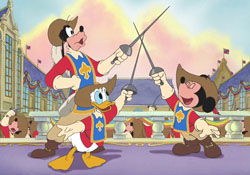Floyd Norman is not just a Disney Legend but a true Disney treasure.
 Floyd is an animator who worked on the Walt Disney animated features Sleeping Beauty and The Sword in the Stone as well as a storyman on The Jungle Book. After Walt Disney’s death in 1966, Norman left the Disney Studio to run his own short-lived animation studio, as well as work at a variety of different animation studios, including Hanna-Barbera.
Floyd is an animator who worked on the Walt Disney animated features Sleeping Beauty and The Sword in the Stone as well as a storyman on The Jungle Book. After Walt Disney’s death in 1966, Norman left the Disney Studio to run his own short-lived animation studio, as well as work at a variety of different animation studios, including Hanna-Barbera.
He returned to Disney in the early 1970s to work on a variety of projects including work for Pixar.
Floyd’s book chronicling his career is titled Animated Life: A lifetime of tips, tricks, techniques and stories from an Animation Legend (Focal Press 2012) and he was the subject of the documentary Floyd Norman: An Animated Life (2016).
A collection of his cartoons Son of Faster Cheaper (Theme Park Press 2015) that includes his time at Disney is also available.
I’ve known Floyd since the 1980s and he has always been gracious to share his time and stories. Recently, I did an extensive interview with him about his work on various Mickey Mouse projects from writing the comic strip to working on storybooks to even some work on merchandise. However, he never officially worked on a Mickey Mouse animated cartoon.

Floyd: “Some years ago, I did do some work on a direct-to-video Mickey feature entitled, Mickey, Donald, Goofy: The Three Musketeers (2004).
In the 1980s, CEO Michael Eisner asked, “Would it be possible to produce an animated feature that would cost less than a hundred million dollars?” At the time the current crop of Disney films in production were going through the roof in terms of cost.
Michael Eisner never got his “budget feature” from animation but his direct-to-video units began cranking out sequels and prequels to the existing Disney library. Of course they were doing it all on a shoestring when compared to what the big ticket features were costing.
 Some years later, I made my way to the second floor of the building where I was suddenly surprised to find a group of old friends and colleagues working away on a project that was so intriguing I knew I wouldn’t be able to stay away. The film in progress was The Three Musketeers project starring Mickey Mouse, Donald Duck, and Goofy. In an era of warmed over sequels and prequels, this little movie was a breath of fresh air.
Some years later, I made my way to the second floor of the building where I was suddenly surprised to find a group of old friends and colleagues working away on a project that was so intriguing I knew I wouldn’t be able to stay away. The film in progress was The Three Musketeers project starring Mickey Mouse, Donald Duck, and Goofy. In an era of warmed over sequels and prequels, this little movie was a breath of fresh air.
Before I go any further, let’s zip back to the 1980s when I made my unexpected return to the Disney studio. I can’t remember every idea in development at the time but one was called Mickey Columbus where the Mouse would play the famous explorer and another was a retelling of the Dumas story of The Three Musketeers. These clever ideas, along with many others would be put on the back burner, or worse – completely forgotten.
Now, here we were in 2002, and that Mickey project that I never thought would see the light of day was finally in development. Better yet, the studio had assembled a crew worthy of such a project, a unique group of creatives with a full understanding of the Disney characters and how to use them.
 They were knowledgeable concerning shorts of the 1940s, and 1950s. These guys in my opinion were the dream team of cartoon story and I had worked with most of them over the years. Chris Otsuki, Kirk Hanson, Bob Taylor, Daan Jippes, Ken Mitchroney, Don Dougherty and Bob McNight were busily crafting this Disney epic the old fashioned way. They understood how the characters had evolved over time, and how they related to each other. I had little doubt this show would be great.
They were knowledgeable concerning shorts of the 1940s, and 1950s. These guys in my opinion were the dream team of cartoon story and I had worked with most of them over the years. Chris Otsuki, Kirk Hanson, Bob Taylor, Daan Jippes, Ken Mitchroney, Don Dougherty and Bob McNight were busily crafting this Disney epic the old fashioned way. They understood how the characters had evolved over time, and how they related to each other. I had little doubt this show would be great.
I continued to work in development on other projects in the Wells Building but I couldn’t stay away from the “Mickey” project. The youthful director, Donavan Cook eventually got used to seeing me hanging around and soon I began sitting in on story pitches and watching over the shoulder as art direction and styling on the movie progressed.
I was so impressed that I knew this little film was deserving of more than a direct-to-video release. In many ways it reminded me of something that had happened back in 1997 when I began work on a direct-to-video sequel called Toy Story 2.
With The Three Musketeers, Disney finally had the perfect Mickey Mouse vehicle and a movie that was sure to play well in theaters. Adding to that, the upcoming celebration of the Mouse’s seventy-fifth birthday was on the horizon. For a company that prides itself on synergy, things couldn’t have been better.

Think of the promotional opportunities a movie starring Disney’s most famous characters would generate. There was no way the Disney Company was going to let this opportunity slip pass them – or so I thought.
The film was released on home video. The film did enjoy a wonderful, but brief big screen presentation at the El Capitan Theater in Hollywood. Those who attended the screening confirmed my belief that the movie would indeed play well theatrically. The theater, packed to the hilt with rambunctious kids fell silent when the movie began. Clearly, this was a movie both parents and kids could enjoy together. The Three Musketeers was the family film many of us had been begging Disney to make for years.
 On video, the movie probably made a truck load of cash for the Walt Disney Company. Having said that, I have to conclude it’s a sin and a shame this wonderful little film was unceremoniously dumped onto the direct-to-video rack. I even emailed Disney film boss, Dick Cook (no relation to director, Donovan) to reconsider the decision to release the movie only to direct-to-video.
On video, the movie probably made a truck load of cash for the Walt Disney Company. Having said that, I have to conclude it’s a sin and a shame this wonderful little film was unceremoniously dumped onto the direct-to-video rack. I even emailed Disney film boss, Dick Cook (no relation to director, Donovan) to reconsider the decision to release the movie only to direct-to-video.
Dick Cook is a nice guy, but I knew even he had to answer to the big boss upstairs. Finally, in my opinion that’s where the rationale for this whole thing becomes clear.
Yes, I’ve heard the arguments why The Three Musketeers failed to gain a theatrical release and those reasons probably make a good deal of sense. Yet, I can’t help wonder if projects such as “Doug,” “Recess,” and “Teacher’s Pet” can score a big screen release, how hard would it be to give the big push to the most recognizable mouse in the world?
Or, perhaps this is not really about shelf space or box office receipts after all. Could there be another agenda, you say?
Or, maybe I’m just being paranoid.”


 Jim Korkis is an internationally respected animation historian who in recent years has devoted his attention to the many worlds of Disney. He was a columnist for a variety of animation magazines. With his former writing partner, John Cawley, he authored several animation related books including The Encyclopedia of Cartoon Superstars, How to Create Animation, Cartoon Confidential and Get Animated’s Animation Art Buyer’s Guide. He taught animation classes at the Disney Institute in Florida as well as instructing classes on acting and animation history for Disney Feature Animation: Florida.
Jim Korkis is an internationally respected animation historian who in recent years has devoted his attention to the many worlds of Disney. He was a columnist for a variety of animation magazines. With his former writing partner, John Cawley, he authored several animation related books including The Encyclopedia of Cartoon Superstars, How to Create Animation, Cartoon Confidential and Get Animated’s Animation Art Buyer’s Guide. He taught animation classes at the Disney Institute in Florida as well as instructing classes on acting and animation history for Disney Feature Animation: Florida.




















































It’s sad to see it go straight to video, but at least the original DVD release had a “DTS mix” option so you can FEEL like you’re in the theater if you have a home theater setup. Not sure about the audio quality of the Blu-ray.
But yeah, no Mickey Mouse theatrical movie except “Fun and Fancy Free” and “Fantasia”. I have no idea why their most protected property NEVER had a theatrical full-length movie. It would definitely be in the “Best Animated Feature” category at the Oscars.
The Blu-ray has a 5.1 DTS-HD mix.
But how does it compare loudness-wise?
Which one is more compressed for DTS and DTS-HD MA (Both Bitstream and LPCM)?
Is there an audiophile in the house?
Much of the answer as to why Mickey hasn’t gotten a theatrical feature probably lies in this part of your comment, ParamountCartoons: he’s arguably Disney’s “most protected property”. So how to handle him for such a big project? Whenever a new Mickey Mouse project comes along, every executive and leader probably starts arguing, “What do we do with him? What kind of personality does he have here? What design style do we go for?” He has become such an icon that there’s likely a lot of inherent pressure and analysis (read: over-analysis) of what audiences might want and expect from a full-length Mickey Mouse feature.
As for this movie: I suspect that even though the final result arguably became better and more enjoyable than several Disney cheapquels that DID get a theatrical release (“Return to Never Land”, anyone?), the strongest argument for keeping it away from theaters may very well have been, ‘Is this really good enough for Mickey Mouse’s feature-length debut on the big screen? Will it live up to people’s expectations?’ The animation, while fun, is cheaper and simpler than big-screen Disney features, and the storyline veers a bit more toward children than I would expect from an actual theatrical Mickey Mouse cartoon. I think I could have done without Mickey spelling out the “moral” in the musketeers’ final fight with Pete, for instance; and some of the characters’ problems (like Donald’s flaw being fear rather than temper) feel forced. Despite this, however, I find the film’s humor charming, and there’s a lof of fun to be had for older Disney fans as well. The filmmakers clearly did the best they could with the material at hand, and the love for the characters is felt throughout. But I suspect that the Walt Disney Company feared they could get a lot of bad press by releasing a Mickey Mouse feature to theaters that was clearly produced on a much cheaper budget than any of the films coming out of their main studios.
Mickey, like Popeye, Betty Boop, Bugs Bunny and a whole lot more should have followed Charlie Chaplin, Buster Keaton, Harold Lloyd, Laurel and Hardy, The Three Stooges and made the leap from short films to features. Why didn’t they? Lack of imagination on the part of producers.
One disappointing aspect of this release is that it did not contain an original musical score, but instead recycled public domain tunes. These were very cleverly done, and provided some interesting and enjoyable moments–but doesn’t Mickey Mouse deserve songs of his own? Also, the portrayal of Mickey, Goofy, and Donald as chronic bunglers and generally inept is unfair to Mickey, who is usually depicted as more astute than the other two. I also feel the animators were trying too hard to throw in slapstick cartoon antics, especially in the early scenes. The whole janitorial bit is way over the top and a bit off-putting for adults who are ready for the main story to get underway. The Disney penchant for wholesale destruction in their movie scenes is a bit unsettling for those of us who have to pay bills and live within a budget.
My personal quibbles aside, this film overall is a delight. It is truly wonderful to see Mickey, Donald, and Goofy in a more or less “epic” adventure like this. The scene where Donald is saddled with the job of relating the exposition of the plot to Mickey is a brilliant in-character bit. Pete makes the ideal villain, as ever, and it’s fun to see Clarabelle enacting the Milady role. The animation is sharp and smooth. It’s a fun film and I agree it deserved a theatrical release.
It would’ve been great seeing this in theaters, had it gotten a theatrical release. To this day, I’m still waiting to see Mickey Mouse get a theatrical feature film of his own.
I am a huge fan of this film’s character design by Bob McKnight and art direction by Toby Bluth. They did a bunch of absolutely gorgeous development art. I didn’t work on the production, but I had the honor of working on the promo art, crew watch and dvd menus/extras. Regarding a theatrical release, I heard that Eisner nixed it with “No one wants to see Mickey Mouse in a theater.”
I think this might have been one of the final straws of the company wanting to Michael to step down.
I love The Three Mustketeers, and the soundtrack album. Even though the songs were based on classical themes, the lyrics were fresh and clever (and I’ve heard some awful ones).
The decision to release it direct to video may not be one to lay at Eisner’s door. He was a proponent of TV animation, since he started it himself and the company gained considerably from it, not only in profits, but in the resurgence in character recognition. It may have actually been Watmart The Great and Powerful, demanding a new direct to video product to have in stores. Disney would have benefited either way, perhaps more by a theatrical released and its benefits of synergy and publicity.
I must be remembered that the tally of “Disney animated features” has varied over the years, as to what films qualiified for inclusion or not. As I recall, The Goofy Movie and The Tigger Movie were on the list at one time (Jim would know better than me). Then as now, it can be more a matter of marketing than historical context. Time will tell how The Three Musketeers will really be counted among the classics.
There’s nothing wrong with having our own personal lists, is there?
My reading was that Wal-Mart would only make a big holiday push for a home video if the movie made a certain figure at the box-office. I’m thinking something in the neighborhood of $600 million? Anyway, after the disappointing performance of “Home on the Range,” Disney couldn’t convince Was-Mart that “# Musketeers” would do any better, so it went in the direct to video schedule.
Maybe if they had kept it going as a theatrical feature, they could’ve afforded to pay for original songs.
Just curious, what exactly did Floyd Norman end up doing on this Mickey Mouse film? He starts out by saying that he did some work on it, but the only thing mentioned later on is that he sat in on story meetings etc. It would be interesting to know more about his contribution.
Jim, one question: I appreciate that you shared these interview quotes from Floyd Norman, but why didn’t you mention that your entire interview with him is available online?? And even better, link to it? Since you didn’t include a link, I thought at first that the interview wasn’t available online at all. It was just coincidence that I stumbled across it while trying to find more info about the “Musketeers” film. Anyway, here are the links to both parts (the Musketeers quote can be found in part two):
https://www.mouseplanet.com/12214/Talking_Mickey_Floyd_Norman__Part_One
https://www.mouseplanet.com/12219/Talking_Mickey_Floyd_Norman__Part_Two
This was probably my favourite project to work on at Disneytoon.
My father was an animator for Disney from 1938 through 1940. He worked on Bambi, Fantasia and Pinocchio as well as a few other shorter films.He wrote a manual on how to use the multi-plane camera. I still have the manual.
If you are interested, contact me.